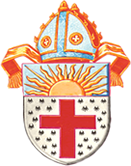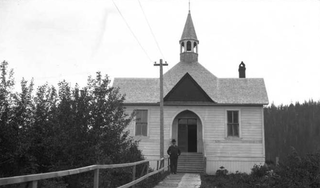
An episcopal polity is a hierarchical form of church governance in which the chief local authorities are called bishops. The word "bishop" here is derived via the British Latin and Vulgar Latin term *ebiscopus/*biscopus, from the Ancient Greek ἐπίσκοπος epískopos meaning "overseer". It is the structure used by many of the major Christian Churches and denominations, such as the Catholic, Eastern Orthodox, Oriental Orthodox, Church of the East, Anglican, Lutheran and Methodist churches or denominations, and other churches founded independently from these lineages.

The Nippon Sei Ko Kai, abbreviated as NSKK, sometimes referred to in English as the Anglican Episcopal Church in Japan, is the national Christian church representing the Province of Japan within the Anglican Communion.
The Continuing Anglican movement, also known as the Anglican Continuum, encompasses a number of Christian churches, principally based in North America, that have an Anglican identity and tradition but are not part of the Anglican Communion.

Comox is a town on the southern coast of the Comox Peninsula in the Strait of Georgia on the eastern coast of Vancouver Island, British Columbia. Thousands of years ago, the warm dry summers, mild winters, fertile soil, and abundant sea life attracted First Nations, who called the area kw'umuxws.

Courtenay is a city of about 26,000 on the east coast of Vancouver Island, in the Canadian province of British Columbia. It is the largest community and only city in the area commonly known as the Comox Valley, and the seat of the Comox Valley Regional District, which replaced the Comox-Strathcona Regional District. Courtenay is 4 km (2.5 mi) west of the town of Comox, 7 km (4.3 mi) northeast of the village of Cumberland, 5 km (3.1 mi) northwest of the unincorporated settlement of Royston, and 108 km (67 mi) northwest of Nanaimo. Along with Nanaimo and Victoria, it is home to The Canadian Scottish Regiment, a Primary Reserve infantry regiment of the Canadian Armed Forces.

The Reformed Episcopal Church (REC) is an Anglican church of evangelical Episcopalian heritage. It was founded in 1873 in New York City by George David Cummins, a former bishop of the Protestant Episcopal Church.

The Diocese of Qu'Appelle in the Anglican Church of Canada lies in the southern third of the civil province of Saskatchewan and contains within its geographical boundaries some 50 per cent of the province's population of one million.

The Episcopal Diocese of Alaska is the diocese of the Episcopal Church in the United States of America with jurisdiction over the state of Alaska. Established in 1895, it has the largest geographical reach of any diocese in the Episcopal Church, with approximately 6,000 members spread across 46 congregations. It is in Province 8. It has no cathedral and the diocesan offices are located in Fairbanks.

St. Philip's Episcopal Church is an historic Episcopal church located at 446 Church Street in Wrangell, Alaska, United States. Its frame vernacular-style church was built as the People's Church in 1903 by a Presbyterian congregation of Alaskan Natives under the direction of its minister, the Rev. Harry Prosper Corser. In 1905 the Rev. Mr. Corser and many of his congregation were received into the Episcopal Church by the Rt. Rev. Peter Trimble Rowe, the first bishop of the Episcopal Diocese of Alaska. Corser was later ordained an Episcopal priest and served the church which was consecrated at St. Phillip's until he retired in 1934. On May 6, 1987, the church was added to the National Register of Historic Places as Saint Philip's Episcopal Church.
The Diocese of Cascadia is a founding diocese of the Anglican Church in North America (ACNA), created in June 2009. It encompasses 25 congregations. The name Cascadia was chosen because the Cascade Range is a prominent geographical feature of the region.
The Diocese of Western Canada and Alaska was a diocese of the Reformed Episcopal Church and the Anglican Church in North America. It also included the Missionary District of Cuba. The diocese was formed in 1996 when the Canadian and American branches of the Reformed Episcopal Church were reunited. It was, at the time, composed of parishes extending back to the founding of the REC in the 1870s. As a part of the Reformed Episcopal Church, the diocese became part of the Anglican Church in North America upon its creation in 2009. It was the smallest of both denominations' dioceses, comprising only two parishes in British Columbia, Canada. Despite its name, the diocese was inactive in Alaska. The diocese also had the Missionary District of Cuba, which was launched in 2003, currently with 20 parishes. Its headquarters were located in Victoria, British Columbia. The first bishop ordinary was E. A. "Ted" Follows, followed by Charles Dorrington.

The Anglican Diocese of the Living Word, formerly the Missionary Diocese of CANA East, is a diocese of the Anglican Church in North America (ACNA). It was one of the four missionary dioceses of the Convocation of Anglicans in North America, a dual church body of the ACNA and the Church of Nigeria. It is officially a full member diocese of ACNA since June 2013. It comprises 43 congregations in 19 American states, with congregations as far as California and Florida but with most concentrated in the northeastern and mid-Atlantic regions. The diocese is divided into nine archdeaconries: Central New York, the Chesapeake, Long Island, the Mid-Atlantic, the Northeast, northeastern New York, the Ohio Valley, the South and the Midwest. The diocese also sponsors a mission in Haiti that includes nine additional congregations. The diocesan office is located at McLean, Virginia. The diocese also includes two affiliated religious communities: the Franciscan Brothers of Bucksport and the Community of St. Mary (East) in New York.

St. John's Reformed Episcopal Church is a historic African-American Anglican church in Charleston, South Carolina. Founded in 1906 and occupying a building built in 1850, the church is a member of the Reformed Episcopal Church's Diocese of the Southeast.

St. George's Anglican Church is a historic Anglican parish in Helmetta, New Jersey. Built as St. George's Episcopal Church to serve families residing in the company town for George Washington Helme's snuff mill, the congregation left the Episcopal Church in 2010 and joined the Anglican Church in North America.

The Missionary Diocese of Cuba is a Cuba-based diocese of the Reformed Episcopal Church. Based in Holguín, the diocese currently has approximately 40 congregations with a combined average attendance of 1,000.

Somerset Anglican Fellowship is a historic church building in Somerset, Pennsylvania. Completed in 1876 as St. Paul's Presbyterian Church, the church is a contributing property to the Uptown Somerset Historic District. and listed on the American Presbyterian/Reformed Historic Sites Registry













